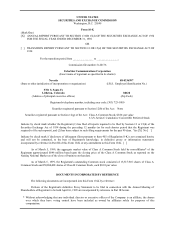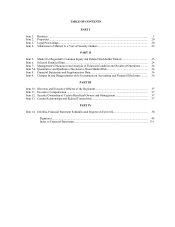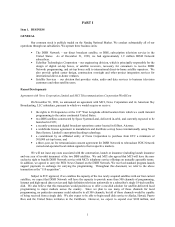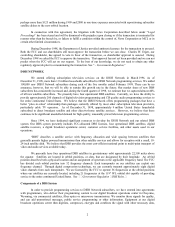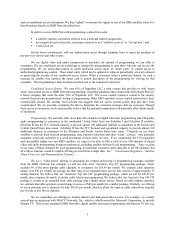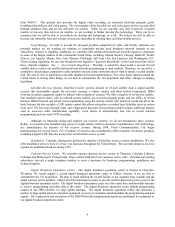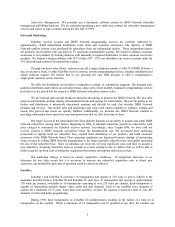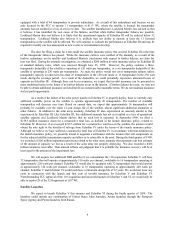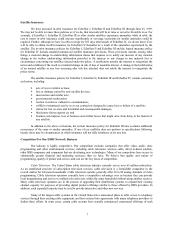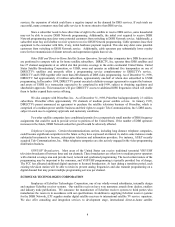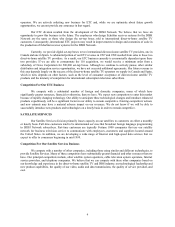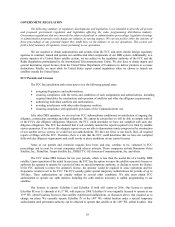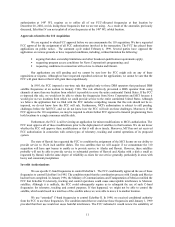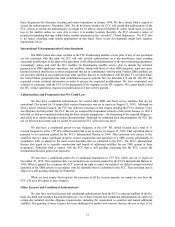Dish Network 1998 Annual Report Download - page 5
Download and view the complete annual report
Please find page 5 of the 1998 Dish Network annual report below. You can navigate through the pages in the report by either clicking on the pages listed below, or by using the keyword search tool below to find specific information within the annual report.3
such as conditional access information. We then “uplink” or transmit the signals to one of our DBS satellites where it is
then broadcast directly to DISH Network subscribers.
In order to receive DISH Network programming, a subscriber needs:
• a satellite antenna, sometimes referred to as a dish and related components;
• an integrated receiver/decoder, sometimes referred to as a “satellite receiver” or “set-top box”; and
• a television set.
Set-top boxes communicate with our authorization center through telephone lines to report the purchase of
pay-per-view movies and other events.
We use digital video and audio compression to maximize the amount of programming we can offer to
consumers. We use conditional access technology to encrypt the programming so only those who pay can receive the
programming. We use microchips placed on credit card-sized access cards, or “smart cards” to control access to
authorized programming content. These smart cards, which can be updated or replaced periodically, are a key element
in preserving the security of our conditional access system. When a consumer orders a particular channel, we send a
message by satellite that instructs the smart card to permit decryption of the programming for viewing by that
consumer. The programming is then decompressed and sent to the consumer’s television.
Conditional Access System. We own 50% of NagraStar LLC, a joint venture that provides us with “smart
cards” that control access to DISH Network programming. NagraStar purchases these smart cards from Nagra Plus SA,
a Swiss company that owns the other 50% of NagraStar LLC. The access control system is central to the security
network that prevents unauthorized viewing of programming. Other DBS operators’ access control systems have been
commercially pirated. We recently received data that suggests that our access control system may also have been
compromised. We are presently evaluating the data to determine the corrective measures that are necessary. Though
there can be no assurance, we do not presently believe that the potential compromise will materially affect future results
of operations.
Programming. We currently offer more than 200 channels of digital television programming and CD-quality
audio programming to consumers in the continental United States from our EchoStar I and EchoStar II satellites.
EchoStar III has the FCC licensed capacity to provide almost 100 additional channels to consumers in the Eastern and
Central United States time zones. EchoStar IV has the FCC licensed and operational capacity to provide almost 100
additional channels to consumers in the Mountain and Pacific United States time zones. Currently we use those
satellites to provide local network programming, data, business television and other “niche” services. Any particular
consumer could only subscribe to a small percentage of those niche services. If we consummate the 110 acquisition
and successfully deploy two new DBS satellites, we expect to be able to offer a total of over 500 channels of digital
video and audio programming broadcast nationwide, including satellite-delivered local programming. Since we plan
to use many of those channels for local programming, no particular consumer could subscribe to all 500 channels, but
all of those channels would be capable of being received from a single dish. See “ – Government Regulation – Satellite
Home Viewer Act and Retransmission Consent”.
We use a “value-based” strategy in structuring the content and pricing of programming packages available
from the DISH Network. For example, we sell our entry-level “America’s Top 40” programming package, which
includes 40 of the most popular cable channels, to consumers for $19.99 per month. We estimate cable operators
charge over $30 per month, on average, for their entry-level expanded basic service that consists of approximately 55
analog channels. We believe that our “America’s Top 100 CD” programming package, which we sell for $28.99 per
month, also compares favorably to similar cable television programming. We believe that our America’s Top 100 CD
package is similar to an expanded basic cable package plus a digital music service. Based on cable industry statistics,
we estimate that cable operators would charge in excess of $40 per month for a similar package. Similarly, we offer up
to seven premium movie channels for only $10.99 per month, which is about the same as cable subscribers typically
pay for one or two movie channels.
We are expanding our offerings to include Internet and high-speed data services. For example, we recently
entered into an agreement with WebTV Networks, Inc., which is wholly-owned by Microsoft Corporation, to provide
Internet TV. This service integrates DISH Network’s digital satellite television programming with Internet TV services

